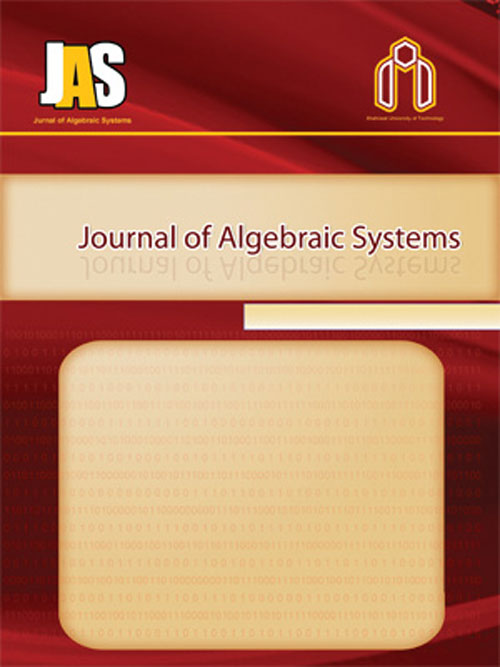فهرست مطالب

Journal of Algebraic Systems
Volume:5 Issue: 1, Summer -Autumn 2017
- تاریخ انتشار: 1396/07/05
- تعداد عناوین: 7
-
-
Pages 1-13In the present paper, by considering the notion of MV-modules which is the structure that naturally correspond to lu-modules over lu-rings, we prove some results on prime A-ideals and state some conditions to obtain a prime A-ideal in MV-modules. Also, we state some conditions that an A-ideal is not prime and investigate conditions that $K\subseteq \bigcup _{i=1}^{n}K_{i}$ implies $K\subseteq K_{j}$, where $K,K_{1},\cdots ,K_{n}$ are A-ideals of A-module M and $1\leq j\leq n$.Keywords: MV-algebra, MV-module, Prime A-ideal
-
Pages 15-25Using a system of axioms among with a modified definition of boundary on the basis of the intuitionistic fuzzy sets, we formulate an inductive structure for the dimension of fuzzy spaces which has been defined by Coker. This new definition of boundary allows to characterize an intuitionistic fuzzy clopen set as a set with zero boundary. Also, some critical properties and applications are established.Keywords: Fuzzy topology, Intuitionistic fuzzy boundary, Fuzzy inductive dimension
-
Pages 27-51Let G be a nite group and C(G) be the family of representative conjugacy classes of subgroups of G. The matrix whose H;K-entry is the number of xed points of the set G=K under the action of H is called the table of marks of G where H;K run through all elements in C(G). In this paper, we compute the table of marks and the markaracter table of groups of order pqr where p, q, r are prime numbers.Keywords: Frobenius group, table of marks, conjugacy class of subgroup
-
Pages 53-64Let $(R, \m)$ be a commutative noetherian local ring and let $\Gamma$ be a finite group. It is proved that if $R$ admits a dualizing module, then the group ring $R\ga$ has a dualizing bimodule as well. Moreover, it is shown that a finitely generated $R\ga$-module $M$ has generalized Gorenstein dimension zero if and only if it has generalized Gorenstein dimension zero as an $R$-module.Keywords: Semi-dualizing bimodules, generalized Gorenstein dimension, group rings
-
Pages 65-72In this paper we study almost uniserial rings and modules. An R−module M is called almost uniserial if any two nonisomorphic submodules are linearly ordered by inclusion. A ring R is an almost left uniserial ring if R_R is almost uniserial. We give some necessary and sufficient condition for an Artinian ring to be almost left uniserial.Keywords: Almost uniserial rings_Almost uniserial modules_Socle of a module
-
Pages 73-84Let $R$ be a commutative ring with identity. The purpose of this paper is to introduce and study two classes of modules over $R$, called $\mbox{Max}$-injective and $\mbox{Max}$-strongly top modules and explore some of their basic properties. Our concern is to extend some properties of $X$-injective and strongly top modules to these classes of modules and obtain some related results.Keywords: Prime submodule, maximal submodule, Max-injective module, Max-strongly top module
-
Pages 85-90The commuting graph of a group is a graph with vertexes set of a subset of a group and two element are adjacent if they commute. The aim of this paper is to obtain the automorphism group of the commuting graph of a conjugacy class in the symmetric groups. The clique number, coloring number, independent number, and diameter of these graphs are also computed.Keywords: symmetric group, automorphim group, commuting graph

